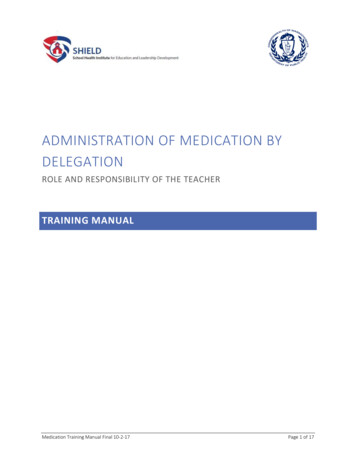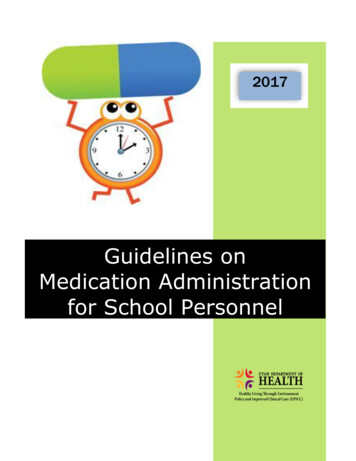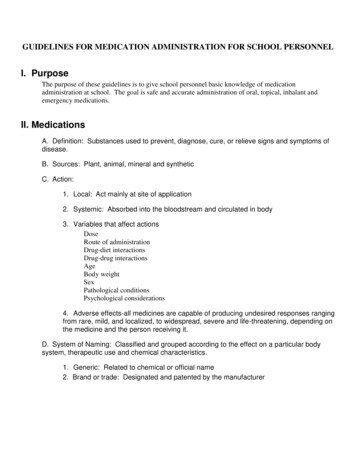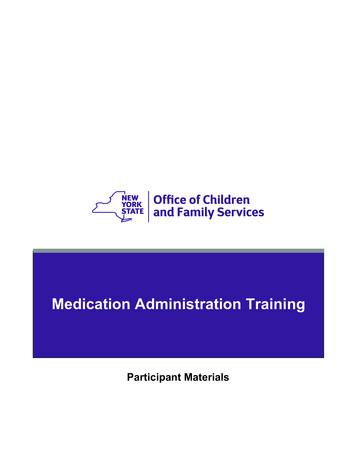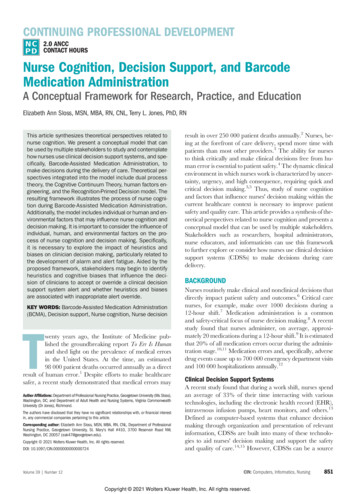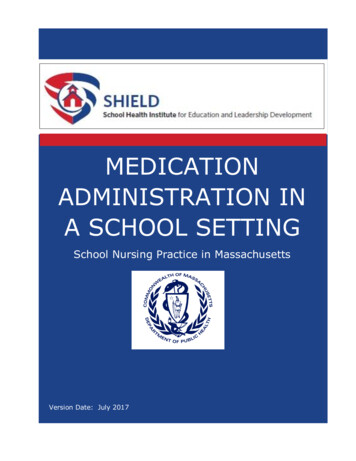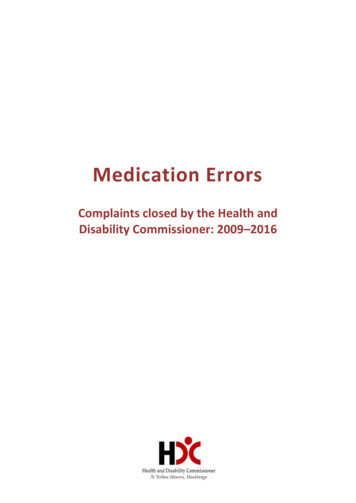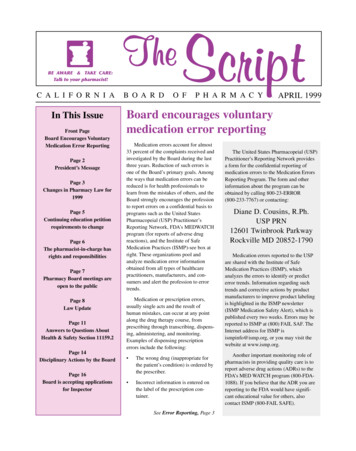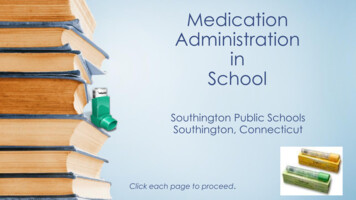
Transcription
MedicationAdministrationinSchoolSouthington Public SchoolsSouthington, ConnecticutClick each page to proceed.
Objectives Understand the definition of qualified personnel. Understand and adhere to medication policy and procedures. Identify the “5 rights” of medication administration. Understand correct administration procedures for oral, inhaled,topical and emergency medications to prepare you to meet withyour School Nurse for demonstration and training.2
Qualified Personnel Definition“Qualified personnel” for schools means (a) a full-time employee who meets thelocal or regional board of education requirements as a principal, teacher,occupational therapist or physical therapist and has been trained in theadministration of medication in accordance with Section 10-212a-3 of theseregulations; (b) a coach and licensed athletic trainer who has been trained in theadministration of medication pursuant to Section 10-212a-8 of these regulations;or(c) a paraprofessional who has been trained in the administration of medicationpursuant to Section 10-212a-9 of these regulations. For school readiness programsand before- and after-school programs, directors or director’s designee, leadteachers and school administrators who have been trained in the administrationof medication may administer medications pursuant to Section 10-212a-10 ofthese regulations.3
SPS Qualified PersonnelThis presentation was developed to provide you with informationabout medication administration before you meet with your SchoolNurse and to have a reference tool for your convenience. There is a brief post-test at the end. Print the test and answer the questions. Bring the completed answer sheet to your scheduled trainingsession with your School Nurse. A School Nurse or Medical Advisor must train Qualified Personnelto administer medication at school.4
SPS Qualified Personnel can administer medications tostudents if they: Are designated by the site administrator to do so Are trained and supervised by the School Nurse or MedicalAdvisor Attend training review annually Are willing to do soThe term “medication” refers to any category of prescriptionand nonprescription preparations and refers to any type of pill,drops, lotion, ointment, cream, liquid, inhalant, intranasal andinjectable substance.5
Before You Begin Check that the Medication Authorization Form is dated within one yearand complete, signed by parent and MD or authorized prescriber.Authorized prescriber is a physician, dentist, optometrist, advanced practiceregistered nurse or physician assistant and, for interscholastic and intramural athletic eventsonly, a podiatrist. Note that prescription medications are in the container labeled by thepharmacy listing the student’s name, provider’s name, medication,dose, frequency and directions for use. Note that over-the-counter medication is in the original container. Wash your hands. It is important to follow hand washing proceduresbefore and after administering medication to the student.6
Check your “5 Rights” Only administer the medication prescribed for that individual student. Follow the student’s Individualized Health Care Plan (IHCP),Emergency Care Plan and/or Medication Administration Plan (MAP) asneeded.The Medication Administration Plan is a documented plan established bythe School Nurse in conjunction with the parent and student regardingthe administration of medication in school. Such plan may be a standalone plan, part of an individualized health care plan, an emergencycare plan or a medication administration form.7
Medication Administration ProcedureFollow a standard routine everytime to minimize errors.Remember the “5 Rights”: Right Student Right Medication Right Dosage Right Time Right RouteHave a plan for giving studentstheir daily medication so they arenot missed or late: 30 minutes before or after thetime authorized is consideredOK It is considered an error if later orearlier unless it is a PRN or “asneeded” medication such as aninhaler or EpiPen If more than 30 minutes late, talkto the parent before giving itAll medication doses administered must be documented on the student’smedication administration record.8
Oral Medications (tablets, capsules, liquids, glucose gel)1.2.3.4.5.6.7.8.9.Wash your hands!Verify the student’s identity. Ask the student to state their name.Review the medication order.Retrieve the appropriate medication container, make sure the labelmatches the student and the physician’s order.Pour the correct dosage into the cap of the bottle or medication cupwithout touching the medication. Double check the medication, dosage,route, time and student then pour the medication into the student’s hand.Provide water as needed.Liquid medication should be held at eye level when measuring dosage.Observe student swallowing their medication.Document the medication administration on the medication log.Return the medication container to its secured storage place.9
Topical Medications Wash hands, wear gloves, and follow the “5 rights” ofmedication administration. Wash area if directed. Apply a thin layer of medication as directed using a tongueblade, cotton swab or gloved finger. Cover area if directed. Remove gloves and wash hands. Document.10
Inhaler use Wash hands, and follow the “5 rights” of medication administration. Remove mouthpiece cover Shake inhaler well for 2 to 5 seconds Place inhaler in mouth Take a deep breath and exhale completely Inhale slowly and deeply through mouth while depressing themedication canister fully Hold breath for 10 seconds Wait 1 minute between puffs Use spacers if available, they help to deliver medication to the lungs Call parent/guardian if no improvement after inhaler use and the11school nurse is not available. Document.
Follow the Asthma Action Plan, the student’s Health Care Plan (IHCP)and/or Medication Administration Plan (MAP) for orders for inhalers.Indications for rescue inhaler use may include: Difficult, shallow rapid breathing Longer time exhaling than inhaling, whistling or wheezing noise withbreathing. Unable to speak more than 1-2 words without taking a breath. Coughing continuously Flaring nostrils Neck/chest muscles pull in (retract) with breathing Cyanotic (turning blue) Student states that his/her chest feels tight or complains of difficultybreathing.12
Example: Asthma IHCP (Individualized Health Care Plan)AssessmentDate/NurseHealth ConcernNsg. DiagnosisStudent Objective(s)willfollow MD ordersand/or asthma planper MD 100% of thetime.At risk forineffective airwayclearance related willto asthma.demonstrate properadministration ofprescribedmedication and willpre-medicate, asneeded, prior toactivities that maytrigger an asthmaepisode per MDorders 100% of thetime.Interventions/Responsible PersonEvaluation/TimelineDiscuss asthma awareness/ MD orders and/or Asthma ActionPlan addressing the warning signs and what to do if an asthmaepisode occurs. NurseDiscuss asthma management measures with student. Nurse Asthma Action Plan provided by MDObtain medication orders for any medications needed inschool. NurseAssist student to administer prescribed medications as needed.NurseMonitor medication administration and reinforce propertechnique as needed Nurse, trained principal or teacherRecord asthma episodes. Nurse MDI received Self-administer MDI Self-administer Checklist completed Nebulizer in schoolInform teachers and other appropriate school staff. Nursewillparticipate in school Assist PE teachers to modify PE requirements as needed. Nurseactivities with modifications made when Other:necessary 100% ofthe time.13
Epinephrine Auto-injector (EpiPen ) EpiPen is a brand name. There are several brands and types ofepinephrine auto injectors. Your School Nurse will train you how to usethem when you schedule to meet. Know which students have an epinephrine auto-injector in school. Anaphylaxis is life-threatening and can occur at any time. Know the symptoms of anaphylaxis which may include:Abnormal breathingChest discomfort or tightnessAnxietyDizziness or light-headednessCoughDifficulty breathingDiarrheaDifficulty swallowingHives, itchinessNausea or vomitingPalpitationsSlurred speechSwelling of the face, eyes, or tongueUnconsciousness14
EpiPen Administration15
Diabetes Medication Wash hands, and follow the “5 rights” of medication administration. Know your student’s plan for Diabetes management in school and onfield trips.Symptoms of low blood sugarmay include: Hunger Shakiness Dizziness Confusion Difficulty speaking Feeling anxious or weakSymptoms of high blood sugarmay include: Increased thirst Blurry vision Dry skin Feeling weak or tired Frequent urination16
Blood glucose levels are checked throughout the day and medicationis given based on those results.Diabetes medications can include glucose tablets, glucose liquid,glucose gel (follow instructions for oral medications, page 7) insulin, orGlucagon injection.Glucagon is a hormone produced in the pancreas. Glucagon is usedto raise very low blood sugar. Glucagon is given by injection in themuscle. It comes as a powder and liquid that will need to be mixed justbefore administering the dose. SPS training for mixing and giving theinjection are in development. Glucagon is administered only if astudent is unconscious from low blood sugar. After the injection, theyshould be turned onto the side to prevent choking if they vomit. Oncethe Glucagon has been given, call 911.17
Possible Side Effects of MedicationsAll medications carry the risk of side effects. Listed below are some of thepossible side effects of some of the more common medications administeredin our schools. Ask your school nurse about specific medication side effectsduring your training session.Epinephrine Auto Injector: increased heart rate, stronger or irregular heartbeat, sweating, nauseaand vomiting, difficulty breathing, paleness, dizziness, weakness or shakiness, headache, apprehension,nervousness or anxiety. These side effects usually go away quickly, especially with rest. 2013 Mylan Specialty L.PBenadryl (Diphenhydramine): dry mouth, nose, and throat, drowsiness, dizziness, nausea, vomiting,loss of appetite, increased chest congestion, headache, muscle weakness, excitement (especially inchildren), nervousness 2013 Medline PlusAlbuterol (Inhaler): Common side effects of VENTOLIN HFA include: palpitations, chest pain, fast heartrate, shakiness, nervousness, headache, pain, dizziness, sore throat, runny nose 1997-2013 GlaxoSmithKline18
Ibuprofen: diarrhea, nausea, gas or bloating, dizziness, nervousness, ringing in the ears, rash, itching,hives, swelling of the eyes, face, throat, arms, hands, feet, ankles, or lower legs, difficulty breathing orswallowing, hoarseness, pain in upper right part of stomach, fast heartbeat 2013 Medline PlusAcetaminophen (Tylenol ): rash, hives, itching, swelling of the face, throat, tongue, lips, eyes,hands, feet, ankles, or lower legs, hoarseness, difficulty breathing or swallowing2013 Medline PlusMethylphenidate (Ritalin ): Common side effects include headache, decreased appetite,stomach ache, nervousness, trouble sleeping, nausea. NovartisIn the uncommon event that a side effect from a medication is observed,follow the prescriber’s instructions on the authorization form, call the schoolnurse and parent/guardian. In any emergency call 911.19
Student Medication Self-administrationStudents may self administer their prescribed medication: When self-administration is authorized by their health care provider When the parent gives written consent When the student is competent to do so After signing a self administration assessment and contract20
Field TripsField Trips are considered part of the school day and thereforemedication or medical procedures that are required during theschool day must also be provided on a field trip.While on a field trip, the principal’s designee trained to administermedication will accompany and stay with the student.The school nurse will make sure the proper medication and/ornecessary supplies are sent on the field trip.Follow the SPS FIELD TRIP MEDICATION AND HEALTH CONCERNSbefore planning your trip. See your school nurse.21
What Is a Medication Error?Dose is omittedWrong medicationWrong studentInaccurate doseWrong timeIncorrect routeErrors may include, but are not limited to, giving the wrong medicine, wrongdosage, wrong student, wrong time, or wrong route.If a med error occurs: notify school nurse, administrator, parents, physicianimmediately;Monitor student / follow physician instructions;If you are away on a field trip after hours call Poison Control at 1-800-222-1222;Complete a Medication Error Report found in the Health Office.22
Abbreviations You May See on Labels PRN – as needed PO – by mouth AC – before meals PC – after meals BID – twice a day TID – three times a day QID – four times a day QOD – every other day Q – every C – with S – without A - before P – after N/V – nausea and vomiting NPO – nothing by mouth GTTS – drops MG – milligram ML – milliliter OZ – ounce QD - everyday TBSP – tablespoon (15ml) Q2H – every 2 hours TSP – teaspoon (5ml)23
Review Know and follow the “5 rights” of medication administration. Document medication administration appropriately after giving themedication. If you have any questions about the medication follow up with theschool nurse. If the student questions the medication, STOP, do not give themedication and recheck the procedure as described in #9. Medication must be kept in a safe location at all times. It is generally accepted that scheduled medication should beadministered within 30 minutes before or after the scheduled dose isdue. Report any medication error immediately.24
ConclusionPlease click the link below to print and complete thispost test and bring to your School Nurse for themedication administration review of individualstudents’ needs and demonstration of administration.See you next year!Medication Administration Post Test
The Medication Administration Plan is a documented plan established by the School Nurse in conjunction with the parent and student regarding the administration of medication in school. Such plan may be a stand-alone plan, part of an individualized health care plan, an emergency care plan or a medication administration form.
